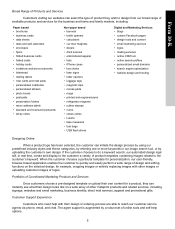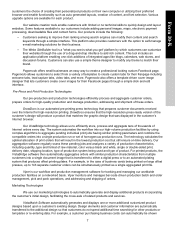Vistaprint 2013 Annual Report Download - page 18
Download and view the complete annual report
Please find page 18 of the 2013 Vistaprint annual report below. You can navigate through the pages in the report by either clicking on the pages listed below, or by using the keyword search tool below to find specific information within the annual report.
15
• currency and interest rate fluctuations, which affect our revenues and costs;
• hedge activity that does not qualify for hedge accounting;
• our ability to attract visitors to our websites and convert those visitors into customers;
• our ability to retain customers and generate repeat purchases;
• shifts in product mix toward less profitable products;
• our ability to manage our production, fulfillment, and support operations;
• costs to produce and deliver our products and provide our services, including the effects of inflation;
• our pricing and marketing strategies and those of our competitors;
• investments in our business to generate or support revenues and operations in future periods, such as
incurring marketing, engineering or consulting expenses in a current period for revenue growth or
support in future periods;
• expenses and charges related to our compensation agreements with our executives and employees;
• costs and charges resulting from litigation;
• significant increases in credits, beyond our estimated allowances, for customers who are not satisfied
with our products;
• changes in our income tax rate;
• costs to acquire businesses or integrate our acquired businesses;
• impairments of our tangible and intangible assets including goodwill; and
• the results of our minority investments.
We base our operating expense budgets in part on expected revenue trends. A portion of our expenses,
such as office leases, depreciation related to previously acquired property and equipment, and personnel costs, are
relatively fixed, and we may be unable to adjust spending quickly enough to offset any revenue shortfall.
Accordingly, any shortfall in revenue may cause significant variation in operating results in any quarter. Based on
the above factors, among others, we believe that quarter-to-quarter comparisons of our operating results may not
be a good indication of our future performance. Our operating results may sometimes be below the expectations of
public market analysts and investors, in which case the price of our ordinary shares will likely decline.
Seasonal fluctuations in our business place a strain on our operations and resources.
Our second fiscal quarter includes the majority of the holiday shopping season and in each of the last three
fiscal years has accounted for more of our revenue and earnings than any other quarter, primarily due to higher
sales of home and family products such as holiday cards, calendars, photo books, and personalized gifts. We
believe our second fiscal quarter is likely to continue to account for a disproportionate amount of our revenue and
earnings for the foreseeable future. In anticipation of increased sales activity during our second fiscal quarter
holiday season, we typically incur significant additional capacity related expenses each year to meet our seasonal
needs, including facility expansions, equipment purchases, and increases in the number of temporary and
permanent employees. Lower than expected sales during the second quarter would likely have a disproportionately
large impact on our operating results and financial condition for the full fiscal year. If we are unable to accurately
forecast and respond to seasonality in our business, our business and results of operations may be materially
harmed.
Form 10-K
























